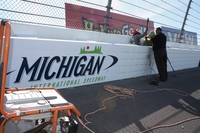Motorsports Venues - SAFER Barrier Removal Kicks Off Historic Project At MIS
 |
BROOKLYN, Aug. 22, 2011: The asphalt is still sizzling from Kyle Busch’s victory burnout following Sunday’s Pure Michigan 400, but that hasn’t stopped Michigan International Speedway from moving toward next season and 44 years of history.
Crews were hard at work Monday removing the SAFER barrier that surrounds the two-mile D-shaped oval in preparation of the track’s repave. The steel and foam energy reduction wall absorbs impacts from crashes.
Some 5,575 feet of SAFER wall will be removed from the outside crash wall. SAFER walls mounted on interior walls on the backstretch, at pit-in and at pit-out will stay in place.
And beginning Tuesday, about 646,000-square-feet of asphalt will be removed when milling begins.
This will be the fourth time MIS has been repaved. The track was repaved in 1977, 1986 and 1995. The track was built in 1968.
“We had some great racing this year; most recently with the 20 lead changes and three- and four-wide racing throughout the Pure Michigan 400,” speedway President Roger Curtis said. “Drivers love this racetrack, so it’s exciting to start another chapter for MIS – a new racing surface.”
Michigan International Speedway’s repave consists of removing the top three-fourths of an inch of existing asphalt pavement, and placing two lifts of asphalt – each 1 ½ inches thick – as a leveling course and a final wearing course.
Once the track has been milled, 22,000 tons of new asphalt will go in its place. Asphalt will be laid down in September.
The $7 million project will be done by Ajax Paving Industries in Troy, Mich., who has extensive background in paving high-speed, high-banked ovals including Phoenix International Raceway, the Chrysler Corp. oval in Chelsea, Mich., and the Ford Romeo Test Track for Ford Motor Co., a five-mile, steep-banked oval used by the manufacturer for testing.
A laser survey of the existing track surface collects approximately 100 million data points, allowing engineers to replicate the original pavement – yet smooth out all of the dips and bumps that have occurred over time.
Those data points have shown the racetrack has variable banking in its 18-degree turns. Variable banking allows cars to carry more speed through the turns, enabling drivers to run multiple lines around the racetrack.
Pit Road was repaved following the June NASCAR Sprint Cup weekend.


